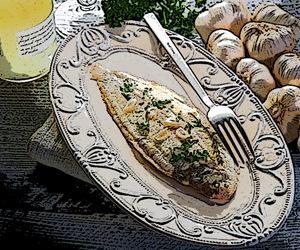The Cancellation Effect In Food And Wine Pairing.
Chapter Nine, Part Five.
 Matching food and wine by weight will put you in the ballpark when choosing the proper wine, but taste is the key to hitting an astronomic-gastronomic home run. Sweet, sour, salt, bitter, umami and piquance interact with one another in predictable ways and once you understand how these principles apply at your dining room table you’ll be able to create some major league food and wine combinations. I lump these interactions into three categories I call the cancellation effect, the cumulative effect, and the neutral effect.
Matching food and wine by weight will put you in the ballpark when choosing the proper wine, but taste is the key to hitting an astronomic-gastronomic home run. Sweet, sour, salt, bitter, umami and piquance interact with one another in predictable ways and once you understand how these principles apply at your dining room table you’ll be able to create some major league food and wine combinations. I lump these interactions into three categories I call the cancellation effect, the cumulative effect, and the neutral effect.
To utilize these concepts you must first identify the most pronounced taste component in your food and wine. Sweet, sour, salt, bitter, umami and piquant tastes are not limited to food and can all be found in wine. When identifying the central taste component of your meal remember to consider the ingredients, sauces, marinades, side dishes, cooking methods, and keep in mind the central ingredient isn’t necessarily its strongest taste.
The cancellation effect occurs when sweet or sour pairings offset each other on your palate. When you taste sweet food your palate adjusts to the sweetness, which reduces or cancels out the sweetness you perceive in your wine. Our palates react this way due to sensory adaptation, a phenomenon that keeps our senses from becoming overloaded by constant stimulation.
The cancellation effect can be a wonderful thing providing your wine possesses sufficient sweetness to begin with, but if you’re drinking a dry wine with sweet food, the cancellation effect will render the wine thin, austere, and devoid of any fruit flavor. Imagine the dinner party havoc this mismatch can create. Your guests will be mortified, your boss will be disappointed and you’ll probably lose your job and your home. Ignore the cancellation effect and you may soon find yourself searching dumpsters for half-full cans of flat beer.
The classic pairing of Sauvignon Blanc and lemon sole is an example of the cancellation effect at its best. Your palate perceives the acidity in Sauvignon Blanc as a sour taste or as a zesty texture but when it is paired with acidic foods like lemon the cancellation effect neutralizes the sour taste and tames the aggressive texture, rendering the wine mellower and making it taste richer.
Certain high-acid red wines, such as Sangiovese, Pinot Noir and Zinfandel can have a textural edginess to them when consumed without food, particularly when they are very young. One of the reasons Chianti (which is composed primarily of Sangiovese) pairs so well with tomato-based dishes is because both are high in acidity. Your palate adjusts to the acidity in one, which reduces your perception of acidity in the other, rendering both more pleasant in the process.
• Summary: As sweetness or sourness (acidity) in food increases, your perception of those elements in wine decreases. Sweet foods will decrease sweetness and increase the sour or bitter characteristics in dry wines. Sour foods will decrease the sour and bitter traits and increase the sweetness in wine. For the cancellation effect to impact your palate in a positive way, pair sweet wines with sweet foods, and high acid wines with high acid foods.























This is very well articulated. When I do my restaurant staff trainings I am always discussing the nuances of food-wine pairing. From now on this article will be on my “must read” list included in my handouts to them.
Thank you Marc. Coming soon are the follow up posts; “The Cumulative Effect”, “The Neutral Effect”, and “The Salt Conundrum”. Stay Tuned…